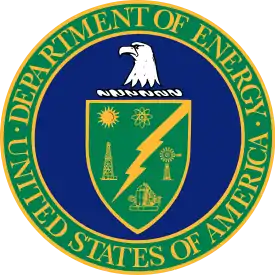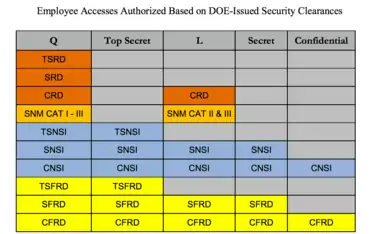Q clearance
Q clearance or Q access authorization is the United States Department of Energy (DOE) security clearance required to access Top Secret Restricted Data, Formerly Restricted Data, and National Security Information, as well as Secret Restricted Data. Restricted Data (RD) is defined in the Atomic Energy Act of 1954 and covers nuclear weapons and related materials. The lower-level L clearance is sufficient for access to Secret Formerly Restricted Data (FRD) and National Security Information, as well as Confidential Restricted Data, Formerly Restricted Data, and National Security Information.[1][2] Access to Restricted Data is only granted on a need-to-know basis to personnel with appropriate clearances.
 Seal of the U. S. Department of Energy |
A Q Clearance is equivalent to a United States Department of Defense Top Secret clearance.[2] "...the Q access authorization corresponds to the background investigation and administrative determination similar to what is completed by other agencies for a Top Secret National Security Information access clearance."[2]
Anyone possessing an active Q clearance is always categorized as holding a National Security Critical-Sensitive position (sensitivity Level 3).[3] Additionally, most Q-cleared incumbents will have collateral responsibilities designating them as Level 4: National Security Special-Sensitive personnel.[4] With these two designations standing as the highest-risk sensitivity levels, occupants of these positions hold extraordinary accountability, having the potential to cause "exceptionally grave" or "inestimable" damage to the national security of the United States.

In addition to classification levels, three categories of classified matter are identified: Restricted Data (RD), Formerly Restricted Data (FRD), and National Security Information (NSI), as well as a class of access-restricted materials: special nuclear material (SNM). The employee must have a security level clearance consistent with their assignment. Common combinations are reflected in the table on the right.
Much of the DOE information at this level requires access to Critical Nuclear Weapon Design Information (CNWDI, pronounced "SIN-widee").[5] Such information bears the page marking Top Secret//RD-CNWDI and the paragraph marking (TS-N) or (TS//RD-CNWDI). The DOE security clearance process is overseen by the Department of Energy Office of Hearings and Appeals.
DOE clearances apply for access specifically relating to atomic or nuclear related materials ("Restricted Data" under the Atomic Energy Act of 1954). The clearance is issued predominantly to non-military personnel. In 1946, U.S. Army Counter Intelligence Corps Major William L. Uanna, in his capacity as the first Chief of the Central Personnel Clearance Office at the newly formed Atomic Energy Commission, named and established the criteria for the Q Clearance.[6] The security clearance process at the DOE is adjudicated by the DOE Office of Hearings and Appeals (OHA), where an individual whose security clearance is at issue may seek to appeal a security clearance decision to an administrative judge, and subsequently, to an Appeal Panel.[7]
As of 1993, Q Clearances required a single-scope background investigation of the previous ten years of the applicant's life by both the Office of Personnel Management and the Federal Bureau of Investigation, and as of 2019, cost $5,596.[8]
In popular culture
"Q" Clearance was a 1986 novel by Peter Benchley, satirizing Cold War secrecy and politics.[9] [10]
In "Nellis", episode 7 of season 6 of the television show Archer, Sterling Archer uses Q clearance to gain access to Area 51 after landing illegally on the airstrip.
The QAnon conspiracy theory is named such because the 4chan poster who created the conspiracy claims to be an individual with Q level security clearance.[11]
See also
- Classified information in the United States
- L clearance
- QAnon, a conspiracy theory surrounding an anonymous poster claiming to have Q clearance
References
- Los Alamos National Laboratory, Clearance Processing Archived October 11, 2006, at the Wayback Machine Retrieved December 15, 2006.
- "Departmental Personnel Security FAQs". U.S. Department of Energy. Retrieved August 2, 2018.
- "OPM Position Designation Tool" (PDF). United States Office of Personnel Management. Retrieved 11 March 2016.
- "Federal Suitability Security Clearance Chart" (PDF).
- Security | UK-USA Classification Equivalency Table | Los Alamos National Laboratory Archived May 10, 2012, at the Wayback Machine
- Girod, Robert J. (2014). Advanced Criminal Investigations and Intelligence Operations: Tradecraft Methods, Practices, Tactics, and Techniques. Boca Raton: Crc Press. p. 23. ISBN 9781482230727. OCLC 910531708.
- The DOE Security Clearance Process, Security Clearance Blog, July 7, 2015
- "Billing Rates". www.dcsa.mil.
- Hardback: ISBN 978-0394553603
- https://www.goodreads.com/book/show/126247.Q_Clearance
- "There is a bizarre conspiracy theory called QAnon. Here's what it actually is". The Independent. 2021-01-21. Retrieved 2021-02-05.
